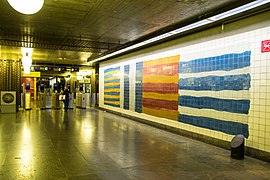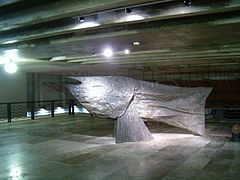Oriente Metro Station

Oriente is a subway station on the Linha Vermelha of the Lisbon Metro , the subway network of the Portuguese capital . The station is located below the bus and train station of the same name, parallel to Avenida de Berlim in the Lisbon municipality of Olivais . The neighboring train stations are Cabo Ruivo and Moscavide . The underground station went into operation on May 19, 1998.
history
construction
The Oriente metro station was initially the end of the Linha Vermelha metro line, which opened in 1998 for the World Exhibition in Lisbon . The line went into operation on May 19, 1998 , together with the Alameda II , Olaias , Bela Vista and Chelas stations . From February 2007 the extension of the Linha Vermelha from Oriente to Portela Airport was under construction. This 3.6-kilometer route, which includes the Aeroporto terminus as well as two other stations ( Encarnação and Moscavide ) went into operation on July 17, 2012. The cost of the extension is EUR 218 million.
East of the underground station is the Oriente long-distance train station , which was also built as part of Expo 98 . There you have the opportunity to change to the numerous suburban, regional and long-distance trains to all parts of Portugal. There is also a large bus station to the west of the subway station.
Artistic arrangement
The basic concept of the underground station was designed by the architect Carlos Sanchez Jorge . As usual, the station has two side platforms, the oversized mezzanine level forms the ceiling of the same, only smaller side halls at both ends. In the conception of Linha Vermelha, Oriente should represent the climax of the artistically highly diverse line. Normally the operating company of the metro, Metropolitano de Lisboa, EPE invites Portuguese artists to work on the various metro structures. In order to do justice to the importance of the world exhibition, there was an exception at the Oriente underground station and a total of eleven different artists from all five continents were invited. Each artist contributed to the overall work of the station in his own way.
Architect Carlos Sanchez Jorge also took part in the artistic design, albeit in an inconspicuous way: he based himself on the motto of the world exhibition Os oceanos: um património para o futuro , in English "The oceans: A legacy for the future" and designed slightly curved ones , wave-like barriers and pillar cladding.
The Portuguese Joaquim Rodrigo , who died during the final work, designed the 2.70 × 12.5 meter large tile painting “Praia do Vau”, which depicts a well-known beach in the Portuguese Algarve . Rodrigo left the Portuguese artist Querubim Lapa specific instructions on how to complete the work. The Austrian Friedensreich Hundertwasser also chose the tiles for his work, he designed a painting with the name Underwater submersion of Atlantis. Yayoi Kusama from Japan designed a nameless tile painting that is on the northernmost platform wall - only interrupted by the tunnel mouth to the sweeping system. SH Raza from India also used traditional tile art to respond to the motto of the world exhibition with the painting “Les Océans”.
Erró from Iceland represented a comic-like symbiosis with numerous mythical creatures, legends and actual events on a large tile plant on the mezzanine floor. Zao Wou-Ki from China also designed a tile plant called L'Atlantic , Abdoulaye Konaté from Mali an equally water-rich tile plant, with numerous colorful ones Fishing. Another tile work comes from the Argentinean Antonio Seguí , which shows just as many maritime details at the southern end of the station - cut through the tunnel mouth in the direction of Cabo Ruivo . Arthur Boyd from Australia also made a tile work showing a naval ship, while Sean Scully from Ireland designed a tile work with abstract art without direct maritime references. In addition to the numerous artistic products that referred to Portuguese tile art, the Polish sculptor Magdalena Abakanowicz also participated with a large bronze statue that is supposed to represent a fish.
Works of art (selection)
course
At the underground station you can change to the bus lines of the companies Carris , Rodoviária de Lisboa , Setubalense and Transportes Sul do Tejo . There are also transfer options to the local and long-distance trains of the railway companies CP Urbanos de Lisboa , CP Regional and CP Longo Curso, as well as to long-distance buses.
| line | course |
|---|---|
| Aeroporto - Encarnação - Moscavide - Oriente - Cabo Ruivo - Olivais - Chelas - Bela Vista - Olaias - Alameda - Saldanha - São Sebastião |
Individual evidence

- ↑ a b c d Information about the underground station. Metropolitano de Lisboa, EPE, accessed March 31, 2013 .
- ^ José António Fonseca: Metro chega ao aeroporto de Lisboa terça-feira. RTP Notícias , July 15, 2011, accessed March 31, 2013 .
- ^ Photo of Hundertwasser's work
Web links
- Area map of the train station (PDF file, 202 KiB)
Coordinates: 38 ° 46 ′ 4.1 ″ N , 9 ° 5 ′ 59.1 ″ W.







